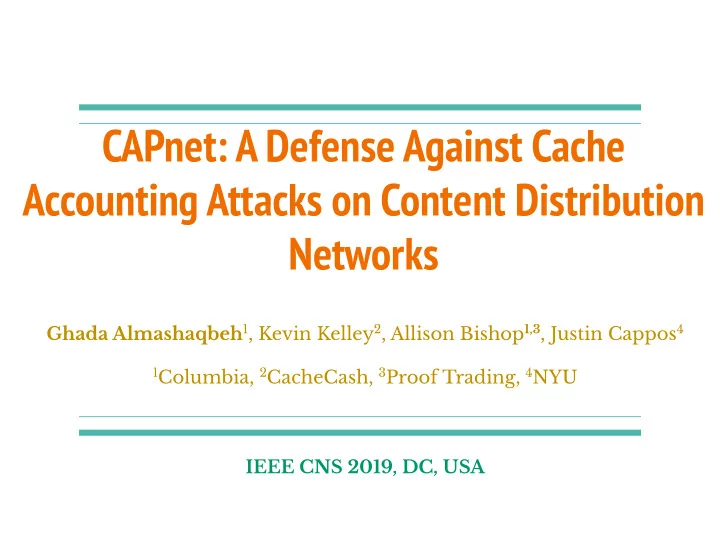

CAPnet: A Defense Against Cache Accounting Attacks on Content Distribution Networks Ghada Almashaqbeh 1 , Kevin Kelley 2 , Allison Bishop 1,3 , Justin Cappos 4 1 Columbia, 2 CacheCash, 3 Proof Trading, 4 NYU IEEE CNS 2019, DC, USA
Outline Background. ● Motivation and problem statement. ● CAPnet design. ● Security analysis. ● Performance evaluation. ● Conclusion. ● 2
Online Content Distribution Dramatic growth over the past decade. ● Video streaming accounts for ~60% of today’s Internet traffic, ○ projected to exceed 80% by 2022. Usually, infrastructure-based content delivery networks (CDNs) are used ● to distribute the load. Through CDN providers, e.g., Akamai. ○ Drawbacks: ● Impose costly and complex business relationships. ○ Require overprovisioning bandwidth to handle peak demands. ○ Issues related to reachability, delays to set up new service, etc. ○ 3
Peer-Assisted CDNs Utilize peer-to-peer data transfers to supplement traditional CDNs . ● Allow anyone to join and distribute content to others. ● Advantages: ● Offer a lower service cost. ○ Create robust and flexible CDN service. ○ Extend network coverage of traditional CDNs. ○ Scale easier with demand. ○ 4
But … Cache Accounting Attacks Clients collude with caches pretending to be ● served. This allows caches to collect rewards without ● doing any actual work. Also, causes problems in network resource ● management. Confirmed by an empirical study on the ● Maze file system and Akamai Netsession. 5
Previous Solutions Do not work in typical P2P networks where untrusted, anonymous nodes ● serve as caches. Rely on activity reports originated by the peers themselves. ○ Such logs can be fabricated. ■ Assume the knowledge of the peer computational power and link ○ delay. Caches cannot be trusted to report such data correctly. ■ Require all nodes who owns a copy of the content to solve a puzzle. ○ Do not work with static content. ■ 6
Our Solution - CAPnet Lets untrusted caches join peer-assisted ● CDNs. Introduces a novel lightweight cache ● accountability puzzle that must be solved using the retrieved content. Allows a publisher to set a bound on the ● amount of bandwidth an attacker must expend when solving the puzzle. 7
System and Threat Model Target peer-assisted CDNs consisting of publishers, clients, and caches. ● A publisher acts as dispatcher assigning caches to serve content requests. ○ When a cache joins a publisher’s network: ● It obtains a full copy of the content, which is divided into data chunks of equal ○ size. It shares a master secret key with the publisher. ○ A client can request n chunks per request. ● Hence, CAPnet’s puzzle is solved over only n chunks (not the whole object). ○ A publisher monitors caches’ IPs to detect Sybils. ● We work in the random oracle model and in the ideal cipher model. ● 8
CAPnet Design 9
Cache Accountability Puzzle Design Puzzle challenge = H(L 9 ) Puzzle solution = L 9 10
Puzzle Solving and Verification Puzzle Solving. ● Same as generation, however, a client does not know the starting ○ piece. It tries pieces from the first data chunk until the solution is found. ○ Puzzle verification. ● A publisher can generate a secret token using a secret PRF. ○ Encrypt this token using the puzzle solution, and send ciphertext to ○ client. A client decrypts once it solves the puzzle and send the token back to ○ the publisher. 11
Security Analysis I Define a δ-bound, which is ratio between the number of pieces a puzzle ● solver retrieve and the total number of pieces in the requested chunks. E.g., 0.9-bound means that a solver would expends a bandwidth cost ○ sufficient to retrieve 90% of the content before solving the puzzle. A publisher can configure the number of puzzle rounds to achieve a ● specific bound. Also, needs to configure the piece size. ○ 12
Security Analysis II A client is colluding with a set of malicious caches, Cm, of size m < n. ● The goal is to solve the puzzle while retrieving the least amount of ○ data. We have a two-entity model: ● The client always retrieve data chunks from honest caches. ○ A malicious cache pools data from other caches in Cm. ○ One will be the puzzle solver and one will be the piece provider. ○ We assume a strong adversary that knows the frequency distribution of ● all pieces in all data chunks. Set piece size <= hash size/m ● Using simulation, we determine the number of puzzle rounds based on ● the desired δ-bound. 13
Parameter Setup - An Example 1 MB chunk size, 16-byte piece size, n = 6 caches. ● 14
Performance Evaluation Benchmarks to evaluate puzzle generation and solving rate. ● Represented in terms of content bitrate. ○ Study the effect of puzzle rounds (or δ bound), chunk size, and piece size. ● 15
CAPnet Efficiency - Generator A publisher can generate puzzles sufficient to serve 870,000 clients watching the same 1080p video concurrently. 16
CAPnet Efficiency - Solver A client can solve puzzles sufficient to retrieve 34 1080p videos concurrently. 17
Conclusion CAPnet is a low-overhead defense mechanism against cache accounting ● attacks. Its core module is a cache accountability puzzle that clients solves before ● caches are given credit. Publishers process small number of pieces, while clients process ○ large amount of the content (based on the δ-bound). Highly efficient, it allows publishers to serve content, and clients to ● retrieve content, at a high bitrate. 18
19
Recommend
More recommend